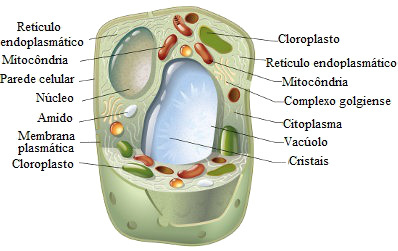At cells they are the smallest living units of an organism and are therefore called fundamental units of life. They are found in all living things and show some differences from group to group. Today we will learn the difference between plant and animal cells.
→ General characteristics of a cell
Despite the differences, in general, we can state that all cells have plasma membrane, cytoplasm and genetic material, which may or may not be located in a nucleus. When a cell does not have a defined nucleus, it is called a prokaryote, but when it has a nucleus, it is called eukaryote.
Animal and plant cells are of the eukaryotic type, so we can say that they are composed of membrane, cytoplasm and nucleus. The plasma membrane is the structure that lines the cell, controlling what enters and leaves these structures. The cytoplasm is the region between the membrane and the nucleus where the cell organelles, that differ in the two cell types. Finally, the nucleus is the region where the genetic information of each living being is stored.
→ Differences between animal and plant cells
Animal and plant cells have some basic differences that allow the organism to survive in different situations. Animals, for example, eat foods that provide organic matter for the cell, which plants do not. In the case of vegetables, which are sessile and do not capture their food, the cells need another way to acquire organic matter for energy production, therefore presenting specialized organelles for this end.

Animal cells have lysosomes and centrioles as typical organelles.
The first feature we can use to differentiate an animal cell from a plant is the presence of cell wall. In animal cells, this envelope is not present and is therefore an exclusive feature of the plant cell. The function of this structure is to give greater resistance to the cell and protect it from the action of organisms that can cause damage and disease.
Analyzing the cytoplasm, we can see that some organelles are present in both cells, but some are unique to a particular cell type. Among the organelles present in animal and plant cells, we can mention ribosomes, endoplasmic reticulum, golgiense complex, peroxisomes and mitochondria.
The typical organelles of the animal cell are the lysosomes and centrioles. Lysosomes are related to intracellular digestion, being responsible for cell nutrition, in addition to helping to recycle some components. Centrioles, in turn, are organelles that act in the cell's division process. It is worth noting that bryophytes and pteridophytes also have this organelle.

Plant cells have chloroplasts as the most striking structures
In plant cells, the exclusive organelles are the plastids, cellular juice vacuole and glyoxisome. Plastids are organelles that have the presence of their own DNA and double membrane as a striking feature. One of the best known plastids is the chloroplast, which is responsible for photosynthesis. The cell juice vacuole is a structure that resembles a bag and acts by storing substances, controlling the pH of the cell, performing osmotic control, among other functions. The glyoxisome, in turn, is an organelle that uses lipids to make carbohydrates.



